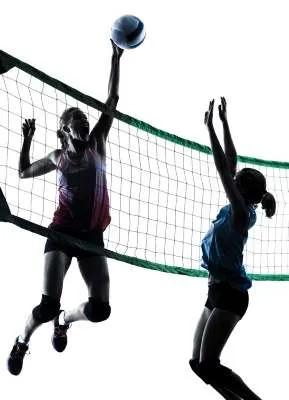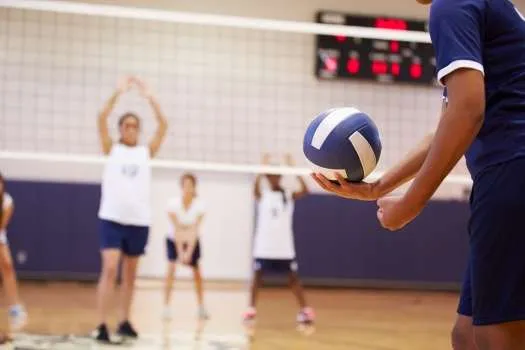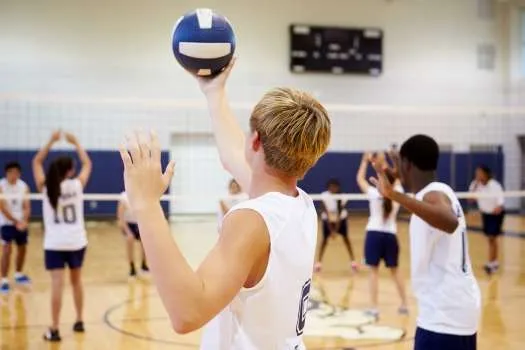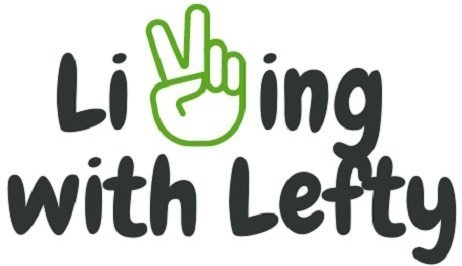When it comes to volleyball, there aren’t many lefties around. Despite the number of left-handed players being staggeringly low, they are high in demand because of a built-in edge they have over the opposing team because of the element of surprise. However, being a left-handed volleyball player is not enough on its own to help you score points against a team. But don’t worry! Living With Lefty has compiled a list of tricks and tips for left handed volleyball players that will help you gain undeniable superiority over whoever you’re playing against.
As a general rule, both lefties and righties should train to play with both hands. This is because although you can choose an optimal position during the initial formation to play volleyball and use your dominating hand to the best of your ability, unless you’re playing the middle blocker/libero position you will need to rotate each time you win a serve. Following this general rule is only the tip of the iceberg when it comes to crucial volleyball tips that left-handed players should keep in mind while training or playing. If you want to get more in-depth information about the best positions and tips & tricks for left-handed volleyball players, keep reading!
Table of Contents
Best Position for a Left Handed Volleyball Player
Representing only 10% of the world population, it doesn’t come as a shock that most volleyball players are treated as righties on the court by their team members and coaches, who are most likely right-handed. This isn’t unique to volleyball, however. Lefties in baseball will tell you the same. Hence, communicating your handedness to your team can come in handy, as will playing the following positions:
Setter
A setter is positioned in the front row on the right side, which is considered one of the most optimal positions for lefty volleyball players. More often than not, playing as a setter would mean that you’d receive the ball on your dominant hand, giving you more control and power over the move.
Moreover, if you receive a good pass, your tip will be unpredictable for the opponent team, and you’ll be quicker in dumping the ball. If you play your moves right, you will also be able to dump the ball over the opposing team’s front blocker, who will be standing in the opposite position. Not dissimilar to the element of surprise in basketball.
The same move from a right-handed player will not only be predictable for the other team, but it will also allow the opposing defense to block the tip or dump successfully. Furthermore, you can also win the mental game in a volleyball match by communicating with your team out loud.
Both the hitter and the setter on the opposing team will likely avoid tipping or dumping the ball in the front row if they know that the southpaw setter is there. We will talk about the importance of communicating with team members later on in this blog, so keep reading!
Right Side Hitter

A left-handed hitter on the right side of the court will find it easier to swing the ball and place the ball at numerous spots to position it for a relatively stronger attack. For this reason, playing the right-side hitter position, which is also in the front row on the right-hand side, is considered excellent for lefties.
The person on the right-hand side in the front row is responsible for defending, blocking, and attacking, mostly when the outside hitter of the opposing team makes a move. They also have the freedom to go across the court and down the line to attack their opponents.
A player on the right side of the court will have their dominant hand on the inside, giving them an edge over the opponents. Matched with a right-handed setter, who will also have their dominant hand on the inside of the court, will prove to be highly advantageous in terms of scoring. It is pertinent to note that a lefty playing on the left side of the court with a righty on the right-hand side will increase threats and cut down options to only one, compared to 2 options with both players’ dominant hands inside the court.
Server

Lefties as servers make excellent volleyball players as well, primarily because they are to produce angles that right-handed players can’t, ultimately serving a ball that the opposing team, specifically the player playing libero, is not used to.
An excellent example of this is a left-handed cross-court serve played from the left side of the court, which will likely fall on the left-hand side wing of the opposite court, where the weaker team players are usually placed. As a result, your team will either win a point by producing a broken play or serving an ace. If you’re interested in learning left-handed serve techniques, you could watch the Cuban volleyball player Fernando Hernandez Ramos, who won the best server award while playing for the national team between 2009 and 2012.
Blocker
Playing the middle blocker at the net is also an excellent position for lefties, especially if they’re relatively taller. As the middle blocker, a left-handed player has the ability to cut out a spike or a slam by the opposing team, given that the spiker is right-handed. If the spiker is right-handed, they will spike the ball with their dominant hand, placing it at the left-handed middle blocker’s dominant hand. Even if the spiker is aware of the left-handed middle blocker, that will force them to play cross-court cuts, ultimately making the spike easier to defend.
Tips for Left Handed Volleyball Players
The following are some of the many tips and tricks that left-handed volleyball players can benefit from:
Play on the Right Side of the Court
As we mentioned earlier, playing on the right-hand side of the court is perfect for left-handed volleyball players because their dominant hand will then be on the inside. Coupling them with a right-handed setter or attacker on the left side of the court will give the team a variety of options since both the players will have their dominant hands inside the court. The plethora of possibilities also include setting an opponent’s serve for a stronger offense or spiking/blocking the ball followed by a jump. While most of the time, left-handed players on the right side of the court set the ball for better offense, you will need to try a variety of unorthodox moves to confuse the opposing team.
Perfect Your Footwork
Footwork is crucial in maximizing the impact of each hit for any player, let alone lefties. However, as a lefty, you may need to adapt a bit and begin with your right foot and in the direction where you want the ball to land in the opposite court. Then, shifting your weight forward, you’ll take a long step with the left foot in accordance with the force with which you’ll need to hit the ball. Once your feet are in the same place, you can jump to hit the ball with sufficient force. As with any player, you must also constantly stay in a position that allows you to run and get to the ball faster, ultimately decreasing your reaction time.
Build Communication With Your Team
As a left-handed player, you need to begin by first communicating your handedness to your coach, who will explain things to you accordingly and position you on the court according to your dominant hand and your underlying abilities.
Moreover, your teammates also need to know that you’re left-handed. As they are likely used to playing with right-handed players, they will also need to adapt their strategy and style to help you utilize your strongest suits. In addition to informing them before the game, lefties must constantly communicate with their team members mid-game to remind them where they will be playing.
For example, if the setter is placing the ball for you to spike or slam, you will need to communicate to them that you’re playing inside the court with your left hand so as not to have your team lose any points.
Don’t Neglect Your Off-Hand Hitting
Off-hand hitting is using either to hit the ball, depending on where it’s falling in your court. Both lefties and righties can benefit from learning to use their non-dominant hand in volleyball as that will allow them to respond to every strike by the opponent successfully.
Develop a Strong Ball Spike
Spiking or slamming the ball almost always wins the team a point, so both left- and right-handed players must perfect their approach for this offensive strike. The general rule is to generate sufficient power to slam the ball over the net and into the opposite court. As mentioned earlier, unlike righties who start with their left foot, lefties will need to approach the ball with their right foot. Furthermore, to ensure that you’re striking the ball with maximum power, you must also rotate your shoulder as you make contact with the ball. Remember not to over-rotate, as that can lead to you losing control of the ball.
Learn How to Serve a Volleyball Left Handed
Unlike the right-handed players, you will need to toss the volleyball with your right hand when serving. Doing so will allow you to use your dominant hand for the serve. Some left-handed volleyball players find it relatively easier to both toss and serve the ball with their left hand. It’s recommended to try both these methods when you’re practicing volleyball serves in order to determine which method best suits your technique and style.

Best Left Handed Volleyball Players in the World
Being left-handed in the world of interactive sports, such as volleyball, is highly advantageous. Despite being a minority in terms of their numbers, some left-handed volleyball players have proved why there’s such a massive demand for them in this sport. This is just the opposite in American football and quarterbacks.
In addition to the Cuban volleyball player, Fernando Hernandez Ramos, mentioned before, who has won numerous awards, including best opposite, top spiker, and best server while playing in the Turkish Championship, there are many other left-handed volleyball players who have won the public’s hearts.
Among such players is also the Serbian player, Saša Starović, who won the gold medal in the European Championships and a bronze medal at the World Championships. He played in the national team between 2007 and 2015. He also had a significant role to play when the Serbian team reached the final of the World League in 2015.
Another Serbian, a female volleyball player Tijana Bošković also surprised opponents on numerous occasions playing left-handed blocker and opposite positions. She won the Best Opposite Player in the Dream Team at the FIVB Club World Championship in 2018. In the same year, she also won the World Championship. At the European Championships and the Rio Olympics, she led her team to win a silver medal and two golds, respectively.
Known as one of the best setters and opposite spikers, Kelly Murphy’s game also led her team to win the gold medal at the World Championships in 2014, a bronze at the Rio Olympics in 2016, and has numerous other medals in volleyball to her name.
Some of the other famous left-handed volleyball players to watch and learn from include:
- Karsta Lowe (USA)
- Miyu Nagaoka (JPN)
- Jovelyn Gonzaga (PHI)
- Sarah Lindsey Pavan (CAN)
- Neslihan Darnel (TUR)
- Paul Carroll (AUS)
- Farhad Gohaemi (IRN)
- Ahmed Salah Abdelhay (EGY)
- Lincoln Williams (AUS)
- Viktor Poletaev (RUS)
- Kunihiro Shimizu (JPN)
- Rolando Cepeda (CUB)
- Uros Kovacevic (SRB)
Concluding Thoughts
Both right- and left-handed volleyball players need to train sufficiently to perfect their technique, method, and style in order to win medals. However, these three things significantly differ in most cases depending on the person’s handedness. Hopefully, we’ve offered you enough information to begin perfecting your skills as a left-handed volleyball player.
